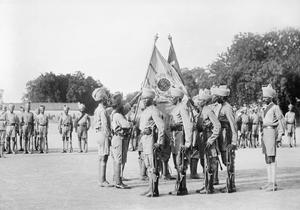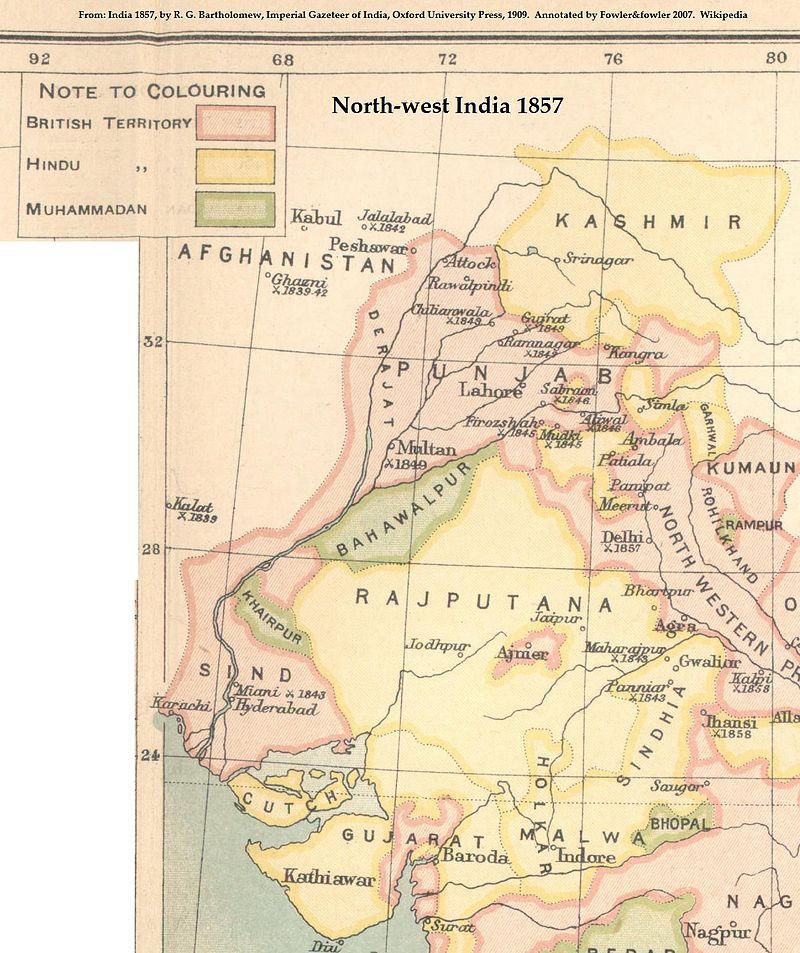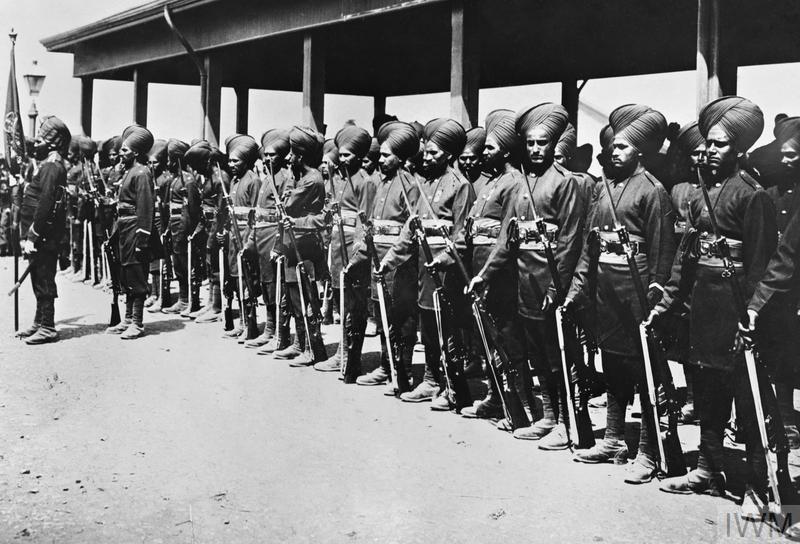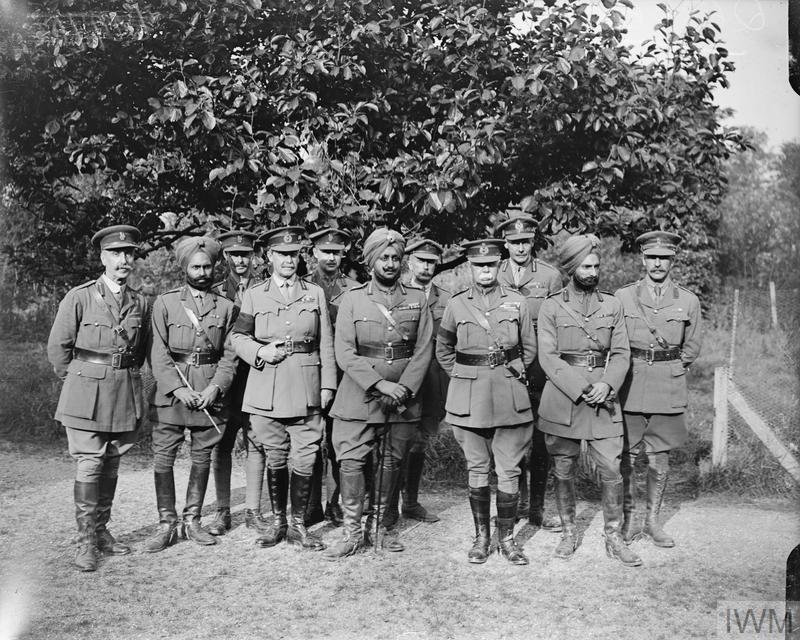How to install the app on iOS
Follow along with the video below to see how to install our site as a web app on your home screen.
Note: This feature may not be available in some browsers.
You are using an out of date browser. It may not display this or other websites correctly.
You should upgrade or use an alternative browser.
You should upgrade or use an alternative browser.
Seen & Unseen military images of Indian subcontinent of the past
- Thread starter third eye
- Start date
third eye
ELITE MEMBER

- Joined
- Aug 24, 2008
- Messages
- 18,515
- Reaction score
- 13
- Country
- Location
THE BRITISH INDIAN ARMY ON THE HOME FRONT, 1914-1918

The swearing in of recruits of the 1st Battalion, 113th Infantry Regiment in Benares.

THE BRITISH INDIAN ARMY ON THE HOME FRONT, 1914-1918
A group of Sikhs of the 1st Battalion, 9th Bhopal Infantry Regiment.
The 9th Bhopal Infantry was an infantry regiment of the British Indian Army. It was raised in 1859, as the Bhopal Levy. It was designated as the 9th Bhopal Infantry in 1903 and became 4th Battalion (Bhopal) 16th Punjab Regiment in 1922. In 1947, it was allocated to the Pakistan Army, where it continues to exist as 17th Battalion The Punjab Regiment.

The swearing in of recruits of the 1st Battalion, 113th Infantry Regiment in Benares.

THE BRITISH INDIAN ARMY ON THE HOME FRONT, 1914-1918
A group of Sikhs of the 1st Battalion, 9th Bhopal Infantry Regiment.
The 9th Bhopal Infantry was an infantry regiment of the British Indian Army. It was raised in 1859, as the Bhopal Levy. It was designated as the 9th Bhopal Infantry in 1903 and became 4th Battalion (Bhopal) 16th Punjab Regiment in 1922. In 1947, it was allocated to the Pakistan Army, where it continues to exist as 17th Battalion The Punjab Regiment.
ChennaiDude
SENIOR MEMBER

- Joined
- Dec 18, 2011
- Messages
- 2,588
- Reaction score
- -5
- Country
- Location
Sorry I wont claim that .
Nor we interested in the certificates of the world .Infact we dont even care .Now we are Indians like any other one.
But I was just pointing about true subcontinent history .
Wrong in there .Modern day India also constitutes South,West,East and Central India .We didnt heard about any Pashtun history in there
The origin of the Nair caste is uncertain. Some anthropologists are of the view that the Nairs are not indigenous to Kerala, One theory is that Nairs are actually the descendants of the Newars of Nepal.
There exists another disputed view that the Nairs and Rajput (A dominant Hindu military caste in northern India) are related, moving south and thus becoming the Nairs .There is no real proof behind this claim, which may or may not be true.
Yet another theory is that the Nairs are indigenous to Kerala, but gained the sharper features and fairer complexion due to intermarriages with the Namboothiris (The namboothiris are the brahmins of kerala....)
In short we can clear these fact - the Nairs are a large matrilineal warrior caste of Kerala State in India. Traditional Nair families are headed by a woman, with whom lives her siblings, sisters' children and other matrilineal relatives. In Nair tradition, a man moves back to his mother's residence shortly after his wedding ceremony and children belong to their mother's lineage.
third eye
ELITE MEMBER

- Joined
- Aug 24, 2008
- Messages
- 18,515
- Reaction score
- 13
- Country
- Location
3rd Sikh Infantry :Officers in Various Dress Orders, 1900

This interesting group shows Indian officers in full dress and the rather wider choice of uniform modelled by four British officers. The Lieutenant sitting on the right is in full dress. The tunic and breeches are drab with black collar, cuffs, light between the two silk trouser stripes and the thin line above the pagri on his helmet. His brown leather pouchbelt has silver fittings.
Next to him sits a 2nd Lieutenant in a drab patrol jacket and plain, unstriped breeches. The patrol jacket is not so tight fitting as the fulldress tunic and differs in the cuff design and the lack of caps on the 'drops' at the end of the five rows of braid. He has a drab pillbox cap decorated with drab silk braid and lace.
Behind them stand two officers in service dress, sam browne belts, breeches and puttees. One carries a helmet without the silver spike and the other, a captain with two medal ribbons, wears a black and drab service cap. This has a small boss on the front of drab silk with a silver bugle-horn on it.
The Indian officers wear drab turbans with black ends edged with an orange fringe. Their pouchbelts have a badge or breastplate like the British officers but they seem less sure what to do with their chains.

This interesting group shows Indian officers in full dress and the rather wider choice of uniform modelled by four British officers. The Lieutenant sitting on the right is in full dress. The tunic and breeches are drab with black collar, cuffs, light between the two silk trouser stripes and the thin line above the pagri on his helmet. His brown leather pouchbelt has silver fittings.
Next to him sits a 2nd Lieutenant in a drab patrol jacket and plain, unstriped breeches. The patrol jacket is not so tight fitting as the fulldress tunic and differs in the cuff design and the lack of caps on the 'drops' at the end of the five rows of braid. He has a drab pillbox cap decorated with drab silk braid and lace.
Behind them stand two officers in service dress, sam browne belts, breeches and puttees. One carries a helmet without the silver spike and the other, a captain with two medal ribbons, wears a black and drab service cap. This has a small boss on the front of drab silk with a silver bugle-horn on it.
The Indian officers wear drab turbans with black ends edged with an orange fringe. Their pouchbelts have a badge or breastplate like the British officers but they seem less sure what to do with their chains.
third eye
ELITE MEMBER

- Joined
- Aug 24, 2008
- Messages
- 18,515
- Reaction score
- 13
- Country
- Location
'Martial Races of India' Deccani Musalmen of the Indian Army, Central Provinces, Bombay, 1944 (c).
Photograph, India, 1944 (c).
The Deccan is a huge area of central and southern India. Maratha converts to Islam from this area were known as Deccani Muslims. The name Deccan is an anglicised form of the Prakrit word 'dakkhin', itself derived from the Sanskrit word 'dak i a', meaning 'South'.

British and Indian officers of the 77th Moplah Rifles, Bangalore, July 1907.
Photograph, India, 1907.
The Moplahs were a Moslem race from the Malabar coast and during the 19th century won themselves a somewhat undeserved reputation as violent troublemakers. An official report had labelled them 'a turbulent and fanatical community'.
In 1902 the Moplah Rifles were raised as the Madras Army endeavoured to recruit more 'warlike' men into its ranks under the influence of the prevailing 'martial races' theory. This photograph was taken shortly before the regiment was disbanded in the aftermath of Lord Kitchener's reforms.

Mohammed Hayat receiving the Order of British India (OBI) at Gardai from Major-General R E Le Fleming, OBE, MC, 1946.
Photograph, India, 1946.
Subadar Mohammed Hayat of the 13th Frontier Force Rifles, was captured by the Japanese at Singapore in February 1942 and put in a Prisoner of War camp. The Japanese at the camp tried to force him and his fellow soldiers to join the Indian National Army (INA), so they could be sent to Burma and fight against Britain. If the Japanese captured Burma, they would be at the gates of India where they could raise the whole country against Britain.
Not only did Subadar Hayat refuse to join, but rallied his men against the Japanese threats. As a punishment he was hung in a cage for 30 days. He continued to shout at his men, urging them to resist and stay loyal to Britain. As a result his food was reduced to a handful of rice a day. After the war he was awarded the OBI for his long and faithful service.
From a photograph album of 328 photographs, 1938-1974 (c) compiled by Captain H G L Brain, 6th Royal Bn, 13th Frontier Force Rifles.

Photograph, India, 1944 (c).
The Deccan is a huge area of central and southern India. Maratha converts to Islam from this area were known as Deccani Muslims. The name Deccan is an anglicised form of the Prakrit word 'dakkhin', itself derived from the Sanskrit word 'dak i a', meaning 'South'.

British and Indian officers of the 77th Moplah Rifles, Bangalore, July 1907.
Photograph, India, 1907.
The Moplahs were a Moslem race from the Malabar coast and during the 19th century won themselves a somewhat undeserved reputation as violent troublemakers. An official report had labelled them 'a turbulent and fanatical community'.
In 1902 the Moplah Rifles were raised as the Madras Army endeavoured to recruit more 'warlike' men into its ranks under the influence of the prevailing 'martial races' theory. This photograph was taken shortly before the regiment was disbanded in the aftermath of Lord Kitchener's reforms.

Mohammed Hayat receiving the Order of British India (OBI) at Gardai from Major-General R E Le Fleming, OBE, MC, 1946.
Photograph, India, 1946.
Subadar Mohammed Hayat of the 13th Frontier Force Rifles, was captured by the Japanese at Singapore in February 1942 and put in a Prisoner of War camp. The Japanese at the camp tried to force him and his fellow soldiers to join the Indian National Army (INA), so they could be sent to Burma and fight against Britain. If the Japanese captured Burma, they would be at the gates of India where they could raise the whole country against Britain.
Not only did Subadar Hayat refuse to join, but rallied his men against the Japanese threats. As a punishment he was hung in a cage for 30 days. He continued to shout at his men, urging them to resist and stay loyal to Britain. As a result his food was reduced to a handful of rice a day. After the war he was awarded the OBI for his long and faithful service.
From a photograph album of 328 photographs, 1938-1974 (c) compiled by Captain H G L Brain, 6th Royal Bn, 13th Frontier Force Rifles.

third eye
ELITE MEMBER

- Joined
- Aug 24, 2008
- Messages
- 18,515
- Reaction score
- 13
- Country
- Location
Punjabi Mahomedans. 3/153 Rifles
The 3rd Battalion was also formed at Sarafand on 24 May 1918 by the transfer of complete companies from:

The 3rd Battalion was also formed at Sarafand on 24 May 1918 by the transfer of complete companies from:
- 105th Mahratta Light Infantry
- 123rd Outram's Rifles
- 2nd Battalion, 124th Duchess of Connaught's Own Baluchistan Infantry
- 125th Napier's Rifles
third eye
ELITE MEMBER

- Joined
- Aug 24, 2008
- Messages
- 18,515
- Reaction score
- 13
- Country
- Location
Bahawalpur was a semiautonomous Princely State within British India lying along the left bank of the River Sutlej in areas now comprising southwestern Punjab . that existed from 1802 to 1955. It was a part of Punjab States Agency . The state covered an area of 45,911 km² (17,494 sq mi) and had a population of 1,341,209 in 1941.

A Major of the Bahawalpur State Forces


A Major of the Bahawalpur State Forces
Attachments
DESERT FIGHTER
ELITE MEMBER

- Joined
- Jan 1, 2010
- Messages
- 46,903
- Reaction score
- 95
- Country
- Location
Baloch soldiers of British army






@Atanz. Saw your thread on the British forum .. Thought you might find these useful .. The turbans worn by Baluch were different.
@Atanz. Saw your thread on the British forum .. Thought you might find these useful .. The turbans worn by Baluch were different.
airmarshal
ELITE MEMBER

- Joined
- Jul 28, 2010
- Messages
- 9,354
- Reaction score
- 11
- Country
- Location
What a nice thread @third eye a shared heritage worth cherishing. Thank you.
DESERT FIGHTER
ELITE MEMBER

- Joined
- Jan 1, 2010
- Messages
- 46,903
- Reaction score
- 95
- Country
- Location
third eye
ELITE MEMBER

- Joined
- Aug 24, 2008
- Messages
- 18,515
- Reaction score
- 13
- Country
- Location
Happy to know someone appreciates such images and linkages to the past.What a nice thread @third eye a shared heritage worth cherishing. Thank you.
A write up on the images,posted would be appreciated & help members to connect with them.
third eye
ELITE MEMBER

- Joined
- Aug 24, 2008
- Messages
- 18,515
- Reaction score
- 13
- Country
- Location
Photograph of a group of Afghan prisoners with a Sikh escort, taken by John Burke in 1878
The Anglo-Russian rivalry (called the Great Game) precipitated the Second Afghan War. Afghanistan was of strategic importance to the British in the defence of their Indian Empire, and the prevention of the spreading influence of Russia. They favoured a Forward Policy of extending India's frontiers to the Hindu Kush and gaining control over Afghanistan. An opportunity presented itself when the Amir Sher Ali turned away a British mission while a Russian mission was visiting his court at Kabul. The British had demanded a permanent mission at Kabul which Sher Ali, trying to keep a balance between the Russians and British, would not permit.
British suspicions of the Amir's perceived susceptibility to the Russians led them to invade Afghanistan.
The three Afghan prisoners captured in the advance through the Khurd Khyber are sitting in the centre of the photograph, surrounded by Sikh guards. The 45th Sikh Regiment was raised in 1856 by Captain Thomas Rattray, and was popularly known as Rattray's Sikhs. It had earlier earned glory with its courage and loyalty to the British at the relief of Lucknow during the Indian Uprising of 1857. The Regiment served in the Fourth Infantry Brigade, part of the Peshawar Valley Field Force, during the Second Afghan War. The prisoners were lucky to have survived because in the harsh conditions and terrain of the Afghan Wars no quarter was given and prisoners taken, on both sides.
![019PHO000000487U00058000[SVC2].jpg](/proxy.php?image=http%3A%2F%2Fogimages.bl.uk%2Fimages%2F019%2F019PHO000000487U00058000%5BSVC2%5D.jpg&hash=87573ffa7e571045b7f4a939c6d45358)
The Anglo-Russian rivalry (called the Great Game) precipitated the Second Afghan War. Afghanistan was of strategic importance to the British in the defence of their Indian Empire, and the prevention of the spreading influence of Russia. They favoured a Forward Policy of extending India's frontiers to the Hindu Kush and gaining control over Afghanistan. An opportunity presented itself when the Amir Sher Ali turned away a British mission while a Russian mission was visiting his court at Kabul. The British had demanded a permanent mission at Kabul which Sher Ali, trying to keep a balance between the Russians and British, would not permit.
British suspicions of the Amir's perceived susceptibility to the Russians led them to invade Afghanistan.
The three Afghan prisoners captured in the advance through the Khurd Khyber are sitting in the centre of the photograph, surrounded by Sikh guards. The 45th Sikh Regiment was raised in 1856 by Captain Thomas Rattray, and was popularly known as Rattray's Sikhs. It had earlier earned glory with its courage and loyalty to the British at the relief of Lucknow during the Indian Uprising of 1857. The Regiment served in the Fourth Infantry Brigade, part of the Peshawar Valley Field Force, during the Second Afghan War. The prisoners were lucky to have survived because in the harsh conditions and terrain of the Afghan Wars no quarter was given and prisoners taken, on both sides.
![019PHO000000487U00058000[SVC2].jpg](/proxy.php?image=http%3A%2F%2Fogimages.bl.uk%2Fimages%2F019%2F019PHO000000487U00058000%5BSVC2%5D.jpg&hash=87573ffa7e571045b7f4a939c6d45358)
Similar threads
- Replies
- 1
- Views
- 2K
- Replies
- 3
- Views
- 1K
- Replies
- 0
- Views
- 2K



